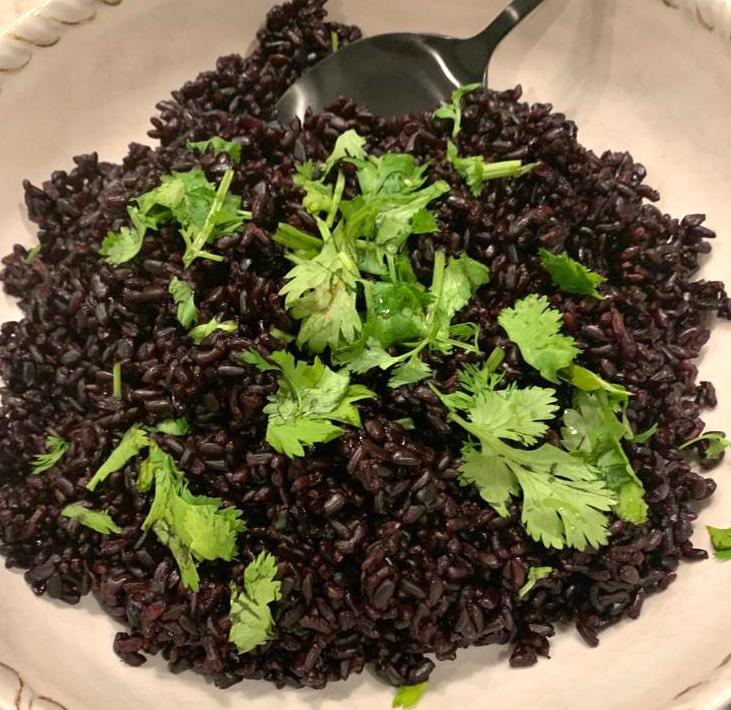Today I am continuing my series, Dr. Monique’s Favorite Food ABCs. The foods that are on this list are here because of both their contributions to mouth-watering dishes as well their health benefits. So far we have discussed the following:
- A for avocado
- B for beans
- C for cilantro
- D for dairy replacements
- E is for egg substitutes
- F for fresh and frozen fruits and vegetables
- G for ginger and garlic
- H for herbs
- I for Indian Spices
- J for jackfruit
- K for Kale
- L for Lentils
- M for Maple Syrup
- N for Nuts
- O for Oranges
- P is for Portobello Mushrooms
- Q for Quinoa
R for Rice. Rice is a no-brainer. No food list would be complete without rice. It is eaten in cultures around the world, including African, Asian, and Latin American, for many good reasons. It is easy to prepare, is very affordable, and has a long shelf life, making it the ideal pantry staple. According to Ricepedia, “rice is the staple food of more than half of the world’s population – more than 3.5 billion people depend on rice for more than 20% of their daily calories.” Rice is eaten all over the world, in Africa, Asia, and Latin America.
There are two main types of rice: white rice and brown rice (or whole grain). Brown rice is definitely the healthier option of the two, as it not processed like white rice. Due to processing, white rice is lower in fiber and nutritional benefits than brown rice. Both are comprised of mostly carbohydrates, so if you are watching your carb intake you may want to try the new plant-based rice substitutes that are available. Cauliflower rice is easy to make at home with a food processor, or you can buy it frozen. Use it just like you would rice, like in this stir fry recipe. There are also rice substitutes made from lentils or chickpeas. Brown rice has many subtypes, including purple, red, and black. Brown rice still has the bran (or outer seed coat) which is high in fiber. It is an unprocessed whole grain and has many more health benefits than white rice. My personal faves are brown, purple, and red rice. I also enjoy basmati and jasmine varieties, particularly in Indian-inspired dishes.
Health benefits of brown rice (and its subtypes):
- Brown rice has a lower glycemic index than white rice, which means it raises blood sugars less than white rice. This is important for diabetics and in general for decreasing the risk of diabetes that can be seen with white rice.
- As a whole grain, it has all the benefits you would expect. Whole grains lower cholesterol and decrease the risk for stroke, heart disease, and type 2 diabetes.
- Purple rice is high in antioxidants, which decrease the risk for heart disease and certain cancers.
- It also contains several B vitamins which are important for healthy muscle, nerve, and heart function.
- Brown rice contains the minerals selenium and magnesium. Selenium is important in hormone function, especially thyroid, and magnesium helps with blood pressure control.
It goes without saying that rice is quite versatile and can be served as a main dish, or added to soups, casseroles, stir-fries, etc. It can be cooked using various methods include using a pressure cooker, rice cooker, or just on the stovetop. Both pressure cookers and rice cookers use steam, but pressure cookers also use pressure as the name implies, and cook rice much faster. This is key when cooking whole grain rice, which takes longer to cook than white rice. Rinsing the rice first removes excess starch, which results in fluffier rice. One-pot meals are another option because the rice cooks along with everything else and makes clean up a breeze. Just the other night I made beans and rice in my pressure cooker, using a 16-bean medley, and a mix of purple, red, and brown rice. For my meat alternative, I chopped up some seitan I had in my freezer and seasoned it all with onion and garlic powder and bay leaves. Thirty minutes later I had a delicious and filling one-pot meal that I will definitely be making again!
A word of caution about rice and arsenic: both brown and white rice may contain this trace element, which over time can increase the risk for chronic diseases such as cancer and diabetes. To decrease the risk, rinse the rice first and cook it in plenty of water (like pasta, instead of the 2:1 water to rice ratio we typically use).
Below is my recipe for Cilantro Purple Rice. This works as a side dish, but can also be used in a burrito or as the base for a veggie bowl with your choice of protein, roasted vegetables, and other hearty toppings. Be sure to post a pic and tag me @physicianinthekitchen if you make this recipe.



